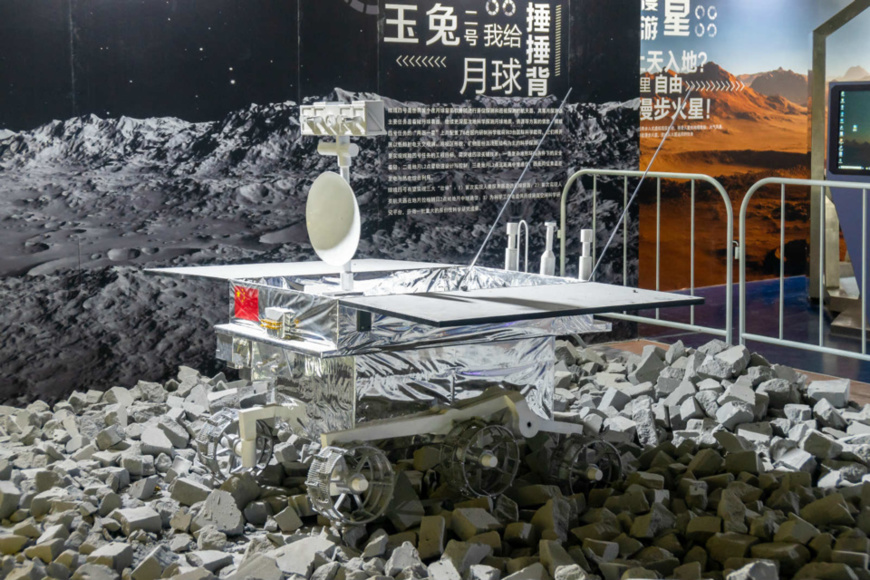China’s Change-4 probe resumes work for 18th lunar day
By Feng Hua, People’s Daily

Photo shows a model of lunar rover Yutu-2 displayed at China Aerospace Art and Technology Exhibition held in Shanghai, January 19, 2020. Exhibits like models of Chang’e-4 probe and Yutu-2 as well as various interactive facilities attracted many children and parents to the exhibition. (Photo by Wang Gang/People’s Daily Online)
After another long “sleep” during the cold night on the moon, the rover and the lander of China’s Chang’e-4 probe were automatically awakened by sunlight at 11:53 a.m. on May 16 and 03:25 a.m. on May 17 respectively, embarking on tasks for the 18th lunar day.
As of May 17, the lunar rover Yutu-2, or Jade Rabbit-2, had worked on the far side of the moon for 500 Earth days since Chang’e-4 probe made the first-ever soft landing on the far side of the moon on January 3, 2019.
Yutu-2 broke the longevity record for working on the surface of the moon set by the Soviet Union’s lunar rover Lunokhod-1 which spent 322 days on the moon, becoming longest-working lunar rover on the moon in human history by far.
During the 500 days, rover Yutu-2, together with the lander of Chang’e-4 probe and the relay satellite Queqiao (Magpie Bridge), achieved massive results in scientific exploration of the moon, providing valuable first-hand information for scientific research.
According to the China Lunar Exploration and Space Program Center of China National Space Administration (CNSA), the center had released more than 210 GB of relevant scientific data by the first anniversary of Chang’e-4’s landing on the moon, contributing to a series of important scientific discoveries made by research teams at home and abroad.
The Chang’e-4 lunar exploration mission involves a lander, lunar rover Yutu-2, and the relay satellite Queqiao, which are altogether equipped with 13 sets of scientific exploration and testing instruments.
There are eight scientific payloads and one test payload on the lander and the lunar rover, including panorama camera, lunar penetrating radar, infrared imaging spectrometer and neutral atom detector, which are all indispensable scientific tools for the work of Yutu-2.
Remarkable as it was, making mankind’s first-ever soft-landing on the far side of the moon is only a minor achievement of Yutu-2.
The rover had travelled 447.68 meters on the moon, conducting scientific detection and tests on lunar rocks, the lunar soil on its track and some impact craters.
Data from the lunar penetrating radar on Yutu-2 has helped uncover the geological structure, components, and evolution mechanism of the landing area of Chang’e-4 probe with a depth of 40 meters.
With the data collected from the infrared imaging spectrometer on Yutu-2, the material composition of the far side of the moon was successfully revealed, which proved that olivine is abundant in lunar mantle and further deepened human understanding of the formation and evolution of the moon.
In addition, the neutral atom detector on Yutu-2 has helped scientists obtain the energy spectrum of energetic neutral atoms on the surface of the moon, verifying that there is a strong correlation between the energy of energetic neutral atoms and the velocity of the incoming solar wind. With actual environmental data about the moon, these findings will serve as strong support for mankind’s manned lunar exploration in the future.
Collaboration is an important feature of China’s space exploration efforts, said an executive with the China Lunar Exploration and Space Program Center of the CNSA, praising the country’s scientific teams for their unity and teamwork in space exploration projects.
In an effort to facilitate China’s first Mars exploration mission, Tianwen-1, the country will make some improvements on its ground control facilities to adapt them to the Tianwen-1 mission. Therefore, the lander and rover of Chang’e-4 probe will conduct detection in situ during the 18th lunar day before new instructions for the next stage, according to the executive.
The infrared imaging spectrometer on the lunar rover will detect certain areas of a depression on the moon after the communication facilities are rebooted, according to the flight control team of the Chang’e-4 mission, which disclosed that scientists found a small depression located three meters southwest of Yutu-2 based on information collected from the panorama camera on the rover during the 17th lunar day.
The depression has a diameter of about 1.3 meters and a depth of no more than 20 centimeters, and it seems that some reflective substance in the central and southeastern areas of the depression gives the areas a distinctive luminance that sets them apart from the lunar soil of the surrounding areas, said the flight control team.












